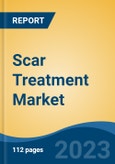Speak directly to the analyst to clarify any post sales queries you may have.
10% Free customizationThis report comes with 10% free customization, enabling you to add data that meets your specific business needs.
Key Market Drivers
Rising Incidence of Road Accidents and Burn Injuries
The global scar treatment market is being largely influenced by the surge in road accidents and burn injuries. Data from the Population Reference Bureau indicates that about 50 million individuals suffer road accident injuries annually, many of whom require scar treatment. In the U.S., the CDC notes around 1.1 million burn injuries each year that require medical care, with roughly 50,000 cases necessitating hospitalization. These conditions frequently result in hypertrophic and keloid scars, causing both physical and emotional distress. This drives up demand for treatment options such as laser therapies, topical products, and surgeries. Additionally, government-backed reimbursement policies in countries like the U.S. further support access to these treatments, encouraging advancements and investment in the scar treatment industry.Key Market Challenges
High Cost of Advanced Scar Treatment Procedures
A key obstacle in the scar treatment market is the considerable cost of advanced therapies, including laser treatments and surgical options. These high expenses can be prohibitive, especially in developing nations, where access to such services is limited. The situation is worsened by the general lack of insurance coverage for aesthetic treatments, forcing patients to pay out-of-pocket. This economic constraint limits market expansion and highlights the need for cost-effective treatment alternatives. Addressing this issue calls for coordinated action among stakeholders to explore affordable innovations and insurance solutions that make scar treatment more accessible.Key Market Trends
Technological Advancements in Scar Treatment Modalities
Technological innovation is significantly enhancing scar treatment outcomes, improving both effectiveness and patient safety. Cutting-edge laser technologies such as Q-switched and fractional CO2 lasers are transforming the treatment of various scars. A notable advancement includes Cynosure’s PicoSure Pro Device, launched in June 2022, aimed at treating acne scars, wrinkles, and pores. Simultaneously, the integration of telemedicine is reshaping how care is delivered. The rise of remote consultations and follow-ups - accelerated by the COVID-19 pandemic - has made scar treatment more convenient and accessible, especially for individuals in underserved or remote locations.Key Market Players
- Smith & Nephew PLC
- Lumenis Ltd.
- Merz Pharmaceuticals, LLC
- Sonoma Pharmaceuticals, Inc.
- Cynosure, LLC
- CCA Industries, Inc.
- Newmedical Technology Inc.
- Mölnlycke Health Care AB
- Perrigo Company plc
- Enaltus LLC
Report Scope:
In this report, the global scar treatment market has been segmented into the following categories, in addition to the industry trends, which have also been detailed below:Scar Treatment Market, By Product:
- Topical Products
- Laser Products
- Injectables
- Others
Scar Treatment Market, By Scar Product:
- Atrophic Scars
- Hypertrophic & Keloid Scars
- Contracture Scars
- Stretch Marks
Scar Treatment Market, By End User:
- Hospitals & Clinics
- Ambulatory Care Centers
- Others
Scar Treatment Market, By Region:
- North America
- United States
- Mexico
- Canada
- Europe
- France
- Germany
- United Kingdom
- Italy
- Spain
- Asia-Pacific
- China
- India
- South Korea
- Japan
- Australia
- South America
- Brazil
- Argentina
- Colombia
- Middle East and Africa
- South Africa
- Saudi Arabia
- UAE
Competitive Landscape
Company Profiles: Detailed analysis of the major companies present in the Global Scar Treatment Market.Available Customizations:
With the given market data, the publisher offers customizations according to a company’s specific needs. The following customization options are available for the report.Company Information
- Detailed analysis and profiling of additional market players (up to five).
This product will be delivered within 1-3 business days.
Table of Contents
Companies Mentioned
- Smith & Nephew PLC
- Lumenis Ltd.
- Merz Pharmaceuticals, LLC
- Sonoma Pharmaceuticals, Inc.
- Cynosure, LLC
- CCA Industries, Inc.
- Newmedical Technology Inc.
- Mölnlycke Health Care AB
- Perrigo Company plc
- Enaltus LLC
Table Information
| Report Attribute | Details |
|---|---|
| No. of Pages | 188 |
| Published | May 2025 |
| Forecast Period | 2024 - 2030 |
| Estimated Market Value ( USD | $ 2.87 Billion |
| Forecasted Market Value ( USD | $ 5.48 Billion |
| Compound Annual Growth Rate | 11.3% |
| Regions Covered | Global |
| No. of Companies Mentioned | 10 |









